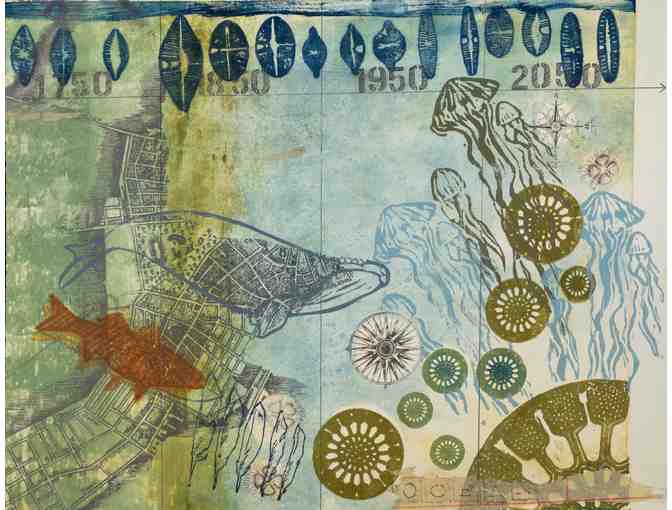Art
Ann Forbush - Annotated Ocean 1
- Item Number
- 6
- Estimated Value
- Priceless
- Sold
- 440 USD to SandyBay20
- Number of Bids
- 24 - Bid History
Item Description
ARTIST: Ann Forbush
TITLE: Annotated Ocean AS26 1
MEDIUM: Monoprint with collage, 16” x 20”, unframed
This original artwork was created for Art on Science: 26 études an internattional portfolio featuring pictures by artists and words by scientists. This written commentary is by Sallie Chisholm, OceanographyDepartment at M.I.T.
I am a biological oceanographer. I study life in the oceans and how it interacts with ocean chemistry and the atmosphere. More specifically I study planktonic microorganisms that form the base of the food web, the phytoplankton. My lab is focused almost exclusively on the study of a tiny microbe called Prochlorococcus which dominates vast ocean regions and is the smallest and most abundant photosynthetic organism on the planet. Through photosynthesis, it converts as much carbon dioxide into living matter each year as do all the crops on land. This amazing little powerhouse was discovered only about 35 years ago.
When I look at this work of art, which includes renderings of phytoplankton, I see beauty. I see change. I see large and small. I see the footprint of humans, and our tendency to think of nature as we know it as the way it has always been; the ever-shifting baseline of what is “natural” is opaque to us. Unlike ancient structures, hieroglyphics, or transcripts, ancient ecosystems cannot be observed. They live only in our imagination. Like works of art, they are self-assembled masterpieces built from the complex interplay between the living and non-living world. But unlike most works of art, they are ephemeral.
The scientific method and the creative process appear at first glance at odds with one another. But are they? The scientific method begins with a hypothesis that can be tested - either through manipulative experiments or observations of patterns in nature. This is science’s way of knowing. It involves a roadmap. The creative process seems to begin with a blank slate. The artist’s inspiration can come completely from within, or be triggered externally. But there are no rules; there is no roadmap. Once begun, art can go in any direction. Not unlike a scientific experiment!
Item Special Note
Free domestic shipping.
All artworks are 16” x 20”, unframed and will be shipped with a printed copy of the scientist’s text.
For further information about the portfolio, please visit our Art on Science: 26 études website: http://AS26project.com
Mosesian Center for the Arts stores data...
Your support matters, so Mosesian Center for the Arts would like to use your information to keep in touch about things that may matter to you. If you choose to hear from Mosesian Center for the Arts, we may contact you in the future about our ongoing efforts.
Your privacy is important to us, so Mosesian Center for the Arts will keep your personal data secure and Mosesian Center for the Arts will not use it for marketing communications which you have not agreed to receive. At any time, you may withdraw consent by emailing Privacy@frontstream.com or by contacting our Privacy Officer. Please see our Privacy Policy found here PrivacyPolicy.

